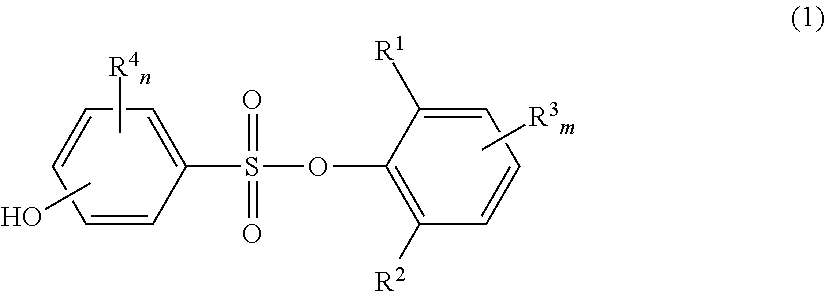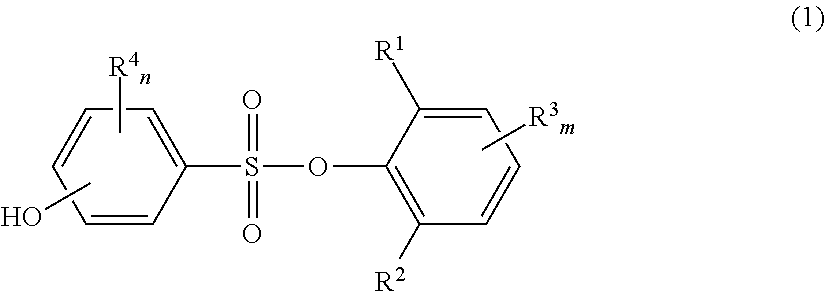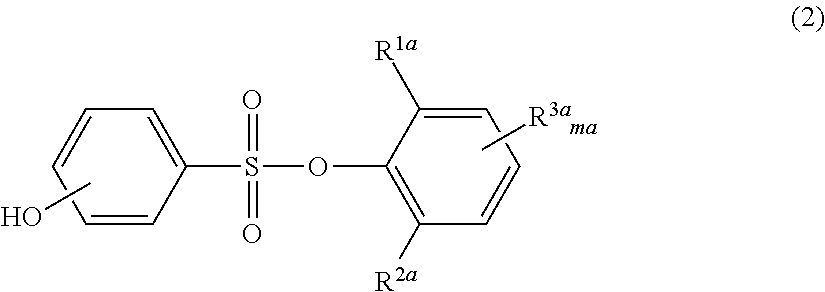Novel phenolsulfonic acid aryl ester derivative, and heat-sensitive recording material using same
a technology of phenolsulfonic acid and aryl ester, which is applied in the field of new phenolsulfonic acid aryl ester derivatives and heat-sensitive recording materials, can solve the problems of environmental hormone activity, insufficient image storability such as plasticizer resistance and heat resistance, and inability to meet the requirements of color-developing sensitivity, etc., to achieve high color-developing sensitivity, good image density, and good image density
- Summary
- Abstract
- Description
- Claims
- Application Information
AI Technical Summary
Benefits of technology
Problems solved by technology
Method used
Image
Examples
synthetic example 1
Synthesis of Exemplary Compound (a3)
[0190]4-Acetoxybenzenesulfonyl chloride (84 g), 2,6-dimethylphenol (36 g) and toluene (400 ml) were placed in a 1000 ml four-necked flask, triethylamine (45 g) was added dropwise with stirring, and the mixture was reacted at 25° C. for 3 hr. After completion of the reaction, 10% aqueous acetic acid solution was added to the reaction mixture, and an extraction operation was performed. The organic layer was washed several times with water until pH was near neutral pH, and toluene was evaporated under reduced pressure from the organic layer. Methanol (100 ml) and potassium carbonate (16 g) were added to the residue, and the mixture was stirred under reflux for 1 hr, and subjected to a deacetylation reaction. After completion of the reaction, 10% aqueous acetic acid solution was added to the reaction mixture, and the mixture was extracted with ethyl acetate. After washing with water and drying (over anhydrous sodium sulfate), ethyl acetate was evapora...
synthetic example 2
Synthesis of Exemplary Compound (a4)
[0212]4-Acetoxybenzenesulfonyl chloride (18.3 g), 2,4,6-trimethylphenol (8.85 g) and toluene (100 ml) were placed in a 300 ml four-necked flask, triethylamine (9.87 g) was added dropwise with stirring, and the mixture was reacted at 25° C. for 3 hr. After completion of the reaction, 10% aqueous acetic acid solution was added to the reaction mixture, and an extraction operation was performed. The organic layer was washed several times with water until pH was near neutral pH, and toluene was evaporated under reduced pressure from the organic layer. Methanol (100 ml) and potassium carbonate (3 g) were added to the residue, and the mixture was stirred under reflux for 1 hr, and subjected to a deacetylation reaction. After completion of the reaction, 10% aqueous acetic acid solution was added to the reaction mixture, and the mixture was extracted with ethyl acetate. After washing with water and drying (over anhydrous sodium sulfate), ethyl acetate was ...
synthetic example 3
Synthesis of Exemplary Compound (a6)
[0222]4-Acetoxybenzenesulfonyl chloride (16.9 g), thymol(2-isopropyl-5-methylphenol) (9.01 g) and toluene (100 ml) were placed in a 300 ml four-necked flask, triethylamine (9.11 g) was added dropwise with stirring, and the mixture was reacted at 25° C. for 3 hr. After completion of the reaction, 10% aqueous acetic acid solution was added to the reaction mixture, and an extraction operation was performed. The organic layer was washed several times with water until pH was near neutral pH, and toluene was evaporated under reduced pressure from the organic layer. Methanol (100 ml) and potassium carbonate (3 g) were added to the residue, and the mixture was stirred under reflux for 1 hr, and subjected to a deacetylation reaction. After completion of the reaction, 10% aqueous acetic acid solution was added to the reaction mixture, and the mixture was extracted with ethyl acetate. After washing with water and drying (over anhydrous sodium sulfate), ethyl...
PUM
| Property | Measurement | Unit |
|---|---|---|
| color | aaaaa | aaaaa |
| color-developing sensitivity | aaaaa | aaaaa |
| plasticizer resistance | aaaaa | aaaaa |
Abstract
Description
Claims
Application Information
 Login to View More
Login to View More - R&D
- Intellectual Property
- Life Sciences
- Materials
- Tech Scout
- Unparalleled Data Quality
- Higher Quality Content
- 60% Fewer Hallucinations
Browse by: Latest US Patents, China's latest patents, Technical Efficacy Thesaurus, Application Domain, Technology Topic, Popular Technical Reports.
© 2025 PatSnap. All rights reserved.Legal|Privacy policy|Modern Slavery Act Transparency Statement|Sitemap|About US| Contact US: help@patsnap.com



